Novel Double Mode Dual-Stator Wound Rotor Synchronous Machine for Variable Speed Applications
Abstract
:1. Introduction
2. Proposed Dual-Mode Dual-Stator Brushless Topology and Operating Principle
2.1. Proposed Dual-Mode Dual-Stator Brushless Topology
2.2. Operating Principle
2.2.1. Mode I: Constant Torque Operation
2.2.2. Mode II: Constant Power Operation
3. Design Consideration of Proposed Machine
3.1. Existing Single-Stator BL-WRSM
3.2. Proposed Dual-Mode Dual-Stator BL-WRSM
3.2.1. Machine Layout
3.2.2. Design Consideration
3.3. Analysis Conditions for Comparison
- (a)
- Both the existing and proposed machines had the same iron material.
- (b)
- For a fair comparison, the number of turns per coil of the stator and field winding were kept equal for both machines. The copper wire diameter was also selected to be the same for the stator and field-winding coil.
- (c)
- The stator current density for both the machines was 4.33 .
- (d)
- The machine volume was almost kept the same for a fair comparison of the current used BL-WRSM and the proposed DMDS-WRSM.
- (e)
- Airgap length was kept the same for both machines.
4. Performance Analysis by 2-D FEA
4.1. Flux Density Distribution Comparison
4.2. Field-Current at Rated Speed
4.3. Torque at the Rated Speed
4.4. Torque-Speed Characteristics of Existing BL-WRSM
4.5. Torque-Speed Characteristics of Proposed DMDS-WRSM
4.6. Performance Comparison
5. Conclusions
Author Contributions
Funding
Data Availability Statement
Conflicts of Interest
References
- Soong, W.; Ertugrul, N. Field-weakening performance of interior permanent-magnet motors. IEEE Trans. Ind. Appl. 2002, 38, 1251–1258. [Google Scholar] [CrossRef] [Green Version]
- Bianchi, N.; Bolognani, S.; Chalmers, B. Salient-rotor PM synchronous motors for an extended flux-weakening operation range. IEEE Trans. Ind. Appl. 2000, 36, 1118–1125. [Google Scholar] [CrossRef]
- Burress, T.A.; Campbell, S.L. Evaluation of the 2010 Toyota Prius Hybrid Synergy Drive System; ORNL/TM-2010/253; Oak Ridge National Laboratory: Oak Ridge, TN, USA, 2011. [Google Scholar]
- Chau, K.T.; Chan, C.C.; Liu, C. Overview of Permanent-Magnet Brushless Drives for Electric and Hybrid Electric Vehicles. IEEE Trans. Ind. Electron. 2008, 55, 2246–2257. [Google Scholar] [CrossRef] [Green Version]
- Barcaro, M.; Bianchi, N. Interior PM Machines Using Ferrite to Replace Rare-Earth Surface PM Machines. IEEE Trans. Ind. Appl. 2014, 50, 979–985. [Google Scholar] [CrossRef]
- Lipo, T.A.; Du, Z.S. Synchronous motor drives—A forgotten option. In Proceedings of the 2015 Intl Aegean Conference on Electrical Machines & Power Electronics (ACEMP), 2015 Intl Conference on Optimization of Electrical & Electronic Equipment (OPTIM) & 2015 Intl Symposium on Advanced Electromechanical Motion Systems (ELECTROMOTION), Side, Turkey, 2–4 September 2015; pp. 1–5. [Google Scholar]
- Popescu, M.; Goss, J.; Staton, D.A.; Hawkins, D.; Chong, Y.C.; Boglietti, A. Electrical Vehicles—Practical Solutions for Power Traction Motor Systems. IEEE Trans. Ind. Appl. 2018, 54, 2751–2762. [Google Scholar] [CrossRef] [Green Version]
- Ali, Q.; Lipo, T.A.; Kwon, B.-I. Design and Analysis of a Novel Brushless Wound Rotor Synchronous Machine. IEEE Trans. Magn. 2015, 51, 8109804. [Google Scholar] [CrossRef]
- Ali, Q.; Atiq, S.; Lipo, T.A.; Kwon, B.I. PM assisted, brushless wound rotor synchronous machine. J. Magn. 2016, 21, 399–404. [Google Scholar] [CrossRef] [Green Version]
- Jawad, G.; Ali, Q.; Lipo, T.A.; Kwon, B.-I. Novel Brushless Wound Rotor Synchronous Machine With Zero-Sequence Third-Harmonic Field Excitation. IEEE Trans. Magn. 2016, 52, 8106104. [Google Scholar] [CrossRef]
- Bukhari, S.S.H.; Sirewal, G.J.; Chachar, F.A.; Ro, J.-S. Dual-Inverter-Controlled Brushless Operation of Wound Rotor Synchronous Machines Based on an Open-Winding Pattern. Energies 2020, 13, 2205. [Google Scholar] [CrossRef]
- Ayub, M.; Bukhari, S.S.H.; Jawad, G.; Kwon, B.-I. Brushless wound field synchronous machine with third-harmonic field excitation using a single inverter. Electr. Eng. 2019, 101, 165–173. [Google Scholar] [CrossRef]
- Yao, F.; An, Q.; Sun, L.; Lipo, T.A. Performance Investigation of a Brushless Synchronous Machine With Additional Harmonic Field Windings. IEEE Trans. Ind. Electron. 2016, 63, 6756–6766. [Google Scholar] [CrossRef]
- Yao, F.; An, Q.; Gao, X.; Sun, L.; Lipo, T.A. Principle of Operation and Performance of a Synchronous Machine Employing a New Harmonic Excitation Scheme. IEEE Trans. Ind. Appl. 2015, 51, 3890–3898. [Google Scholar] [CrossRef]
- Hussain, A.; Kwon, B.-I. A new brushless wound rotor synchronous machine using a special stator winding arrangement. Electr. Eng. 2017, 100, 1797–1804. [Google Scholar] [CrossRef]
- Ayub, M.; Hussain, A.; Jawad, G.; Kwon, B.-I. Brushless Operation of a Wound-Field Synchronous Machine Using a Novel Winding Scheme. IEEE Trans. Magn. 2019, 55, 8201104. [Google Scholar] [CrossRef]
- Hussain, A.; Atiq, S.; Kwon, B.-I. Optimal Design and Experimental Verification of Wound Rotor Synchronous Machine Using Subharmonic Excitation for Brushless Operation. Energies 2018, 11, 554. [Google Scholar] [CrossRef] [Green Version]
- Hussain, A.; Atiq, S.; Kwon, B.-I. Consequent-Pole Hybrid Brushless Wound-Rotor Synchronous Machine. IEEE Trans. Magn. 2018, 54, 8206205. [Google Scholar] [CrossRef]
- Hussain, A.; Baig, Z.; Toor, W.T.; Ali, U.; Idrees, M.; Al Shloul, T.; Ghadi, Y.Y.; Alkahtani, H.K. Wound Rotor Synchronous Motor as Promising Solution for Traction Applications. Electronics 2022, 11, 4116. [Google Scholar] [CrossRef]
- Ayub, M.; Atiq, S.; Ali, Q.; Hussain, A.; Kwon, B.-I. Dual-Mode Wound Rotor Synchronous Machine for Variable Speed Applications. IEEE Access 2020, 8, 115812–115822. [Google Scholar] [CrossRef]
- Han, P.; Cheng, M.; Jiang, Y.; Chen, Z. Torque/Power Density Optimization of a Dual-Stator Brushless Doubly-Fed Induction Generator for Wind Power Application. IEEE Trans. Ind. Electron. 2017, 64, 9864–9875. [Google Scholar] [CrossRef]
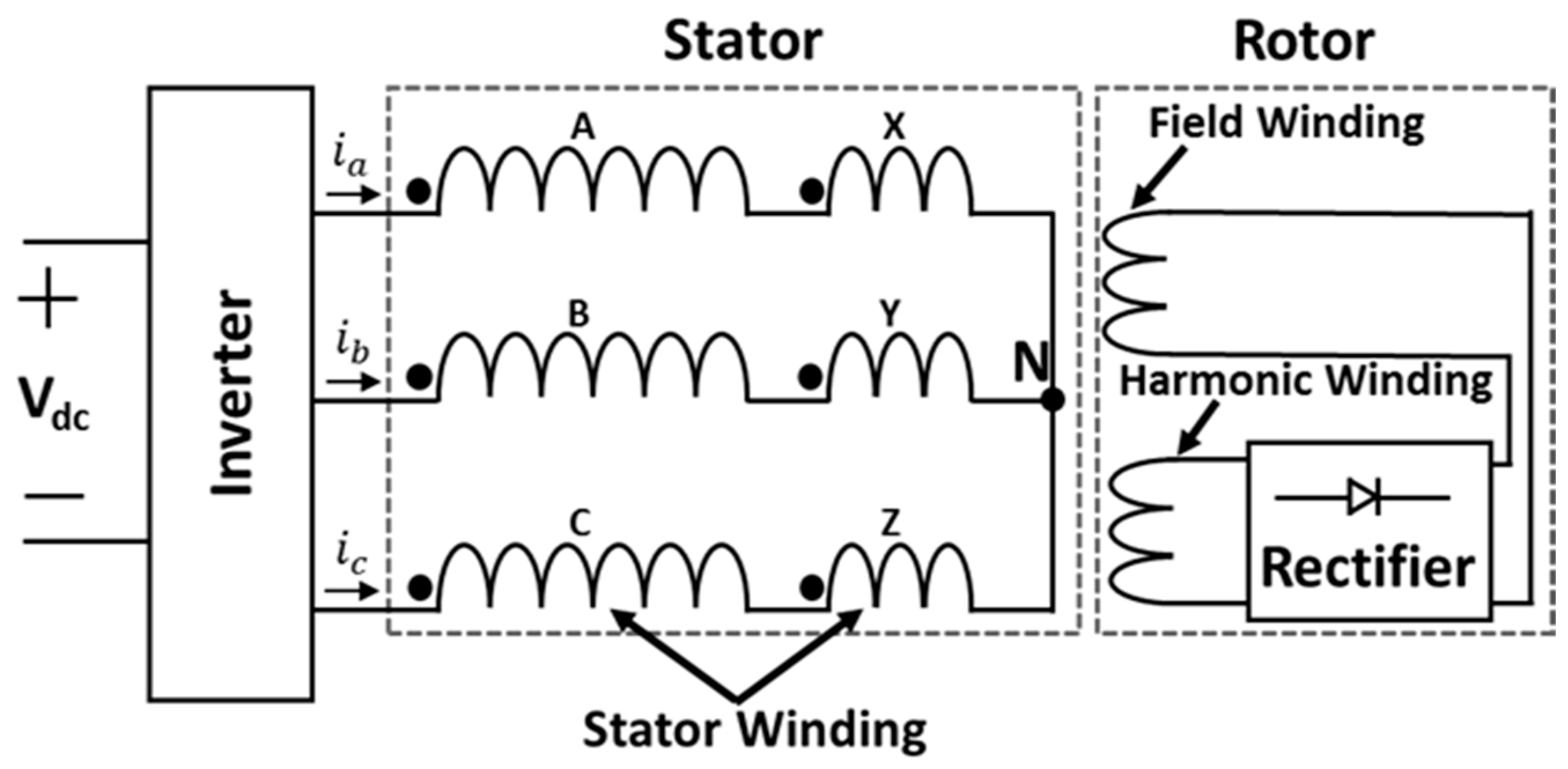

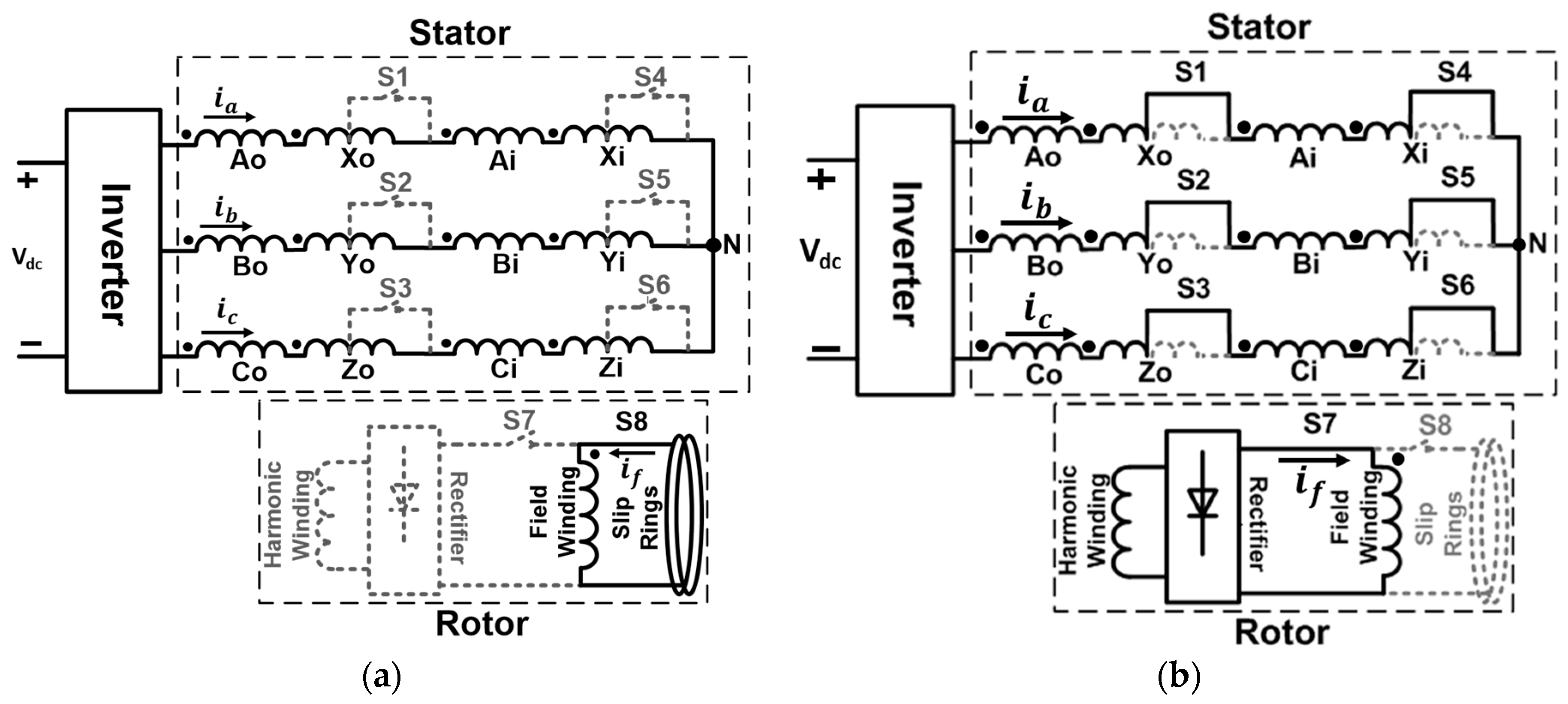
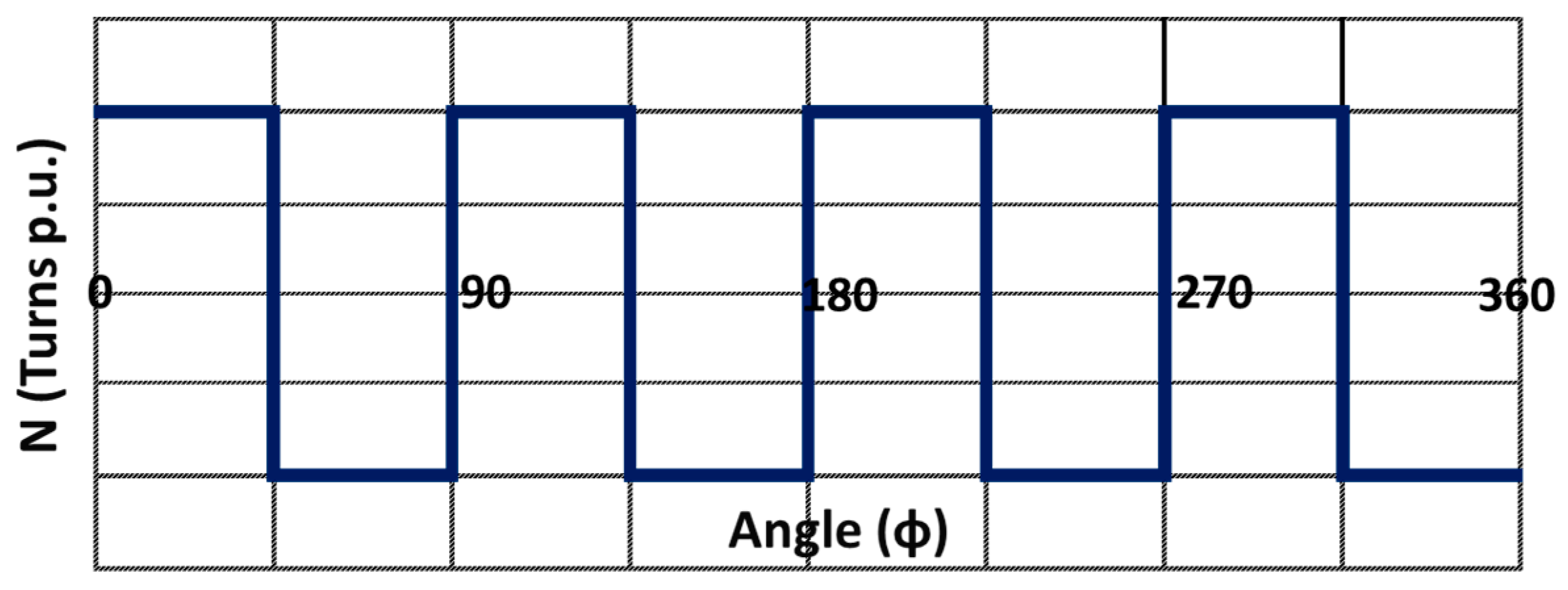
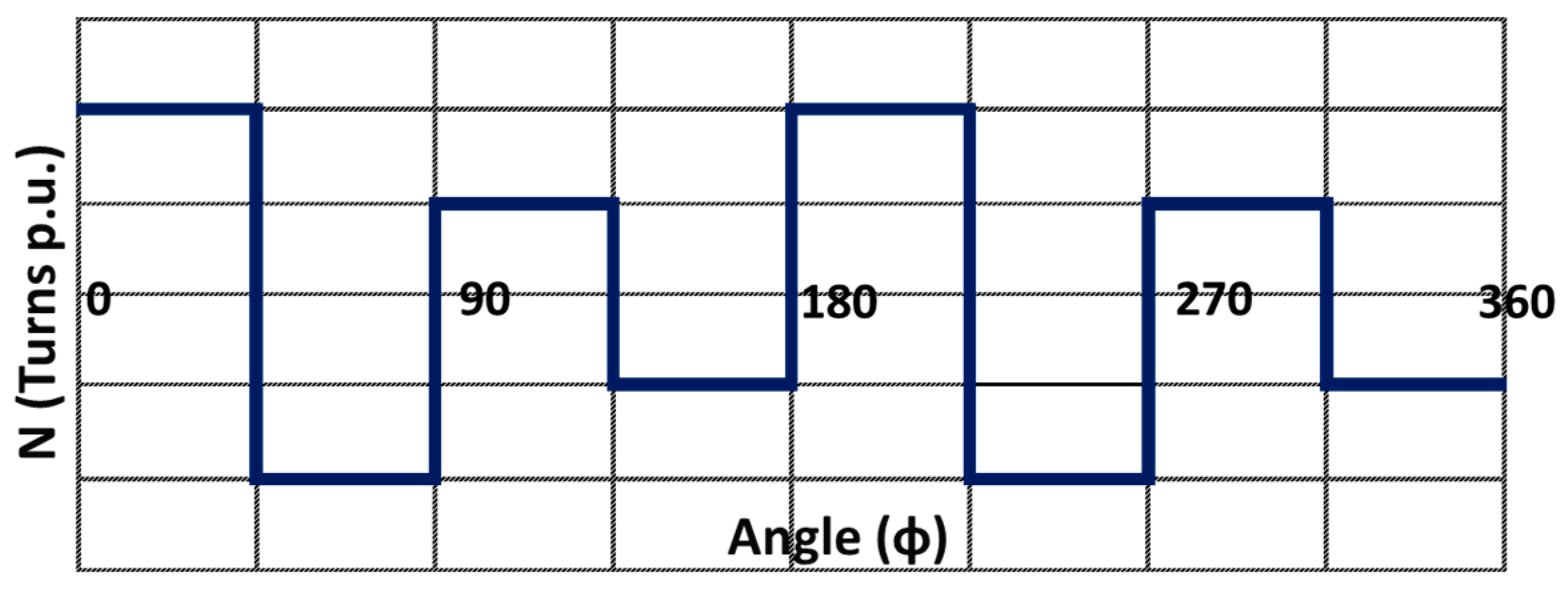

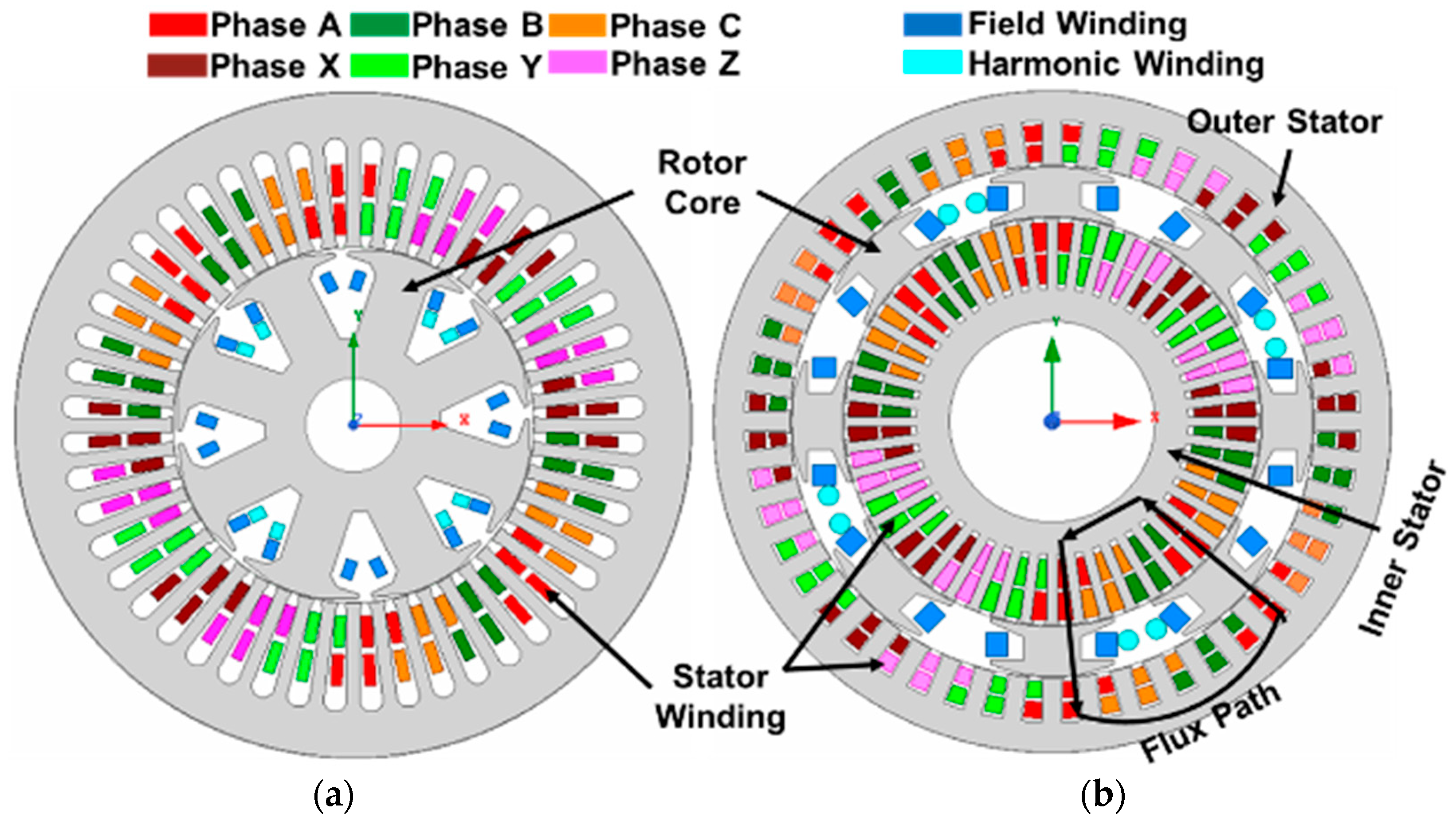


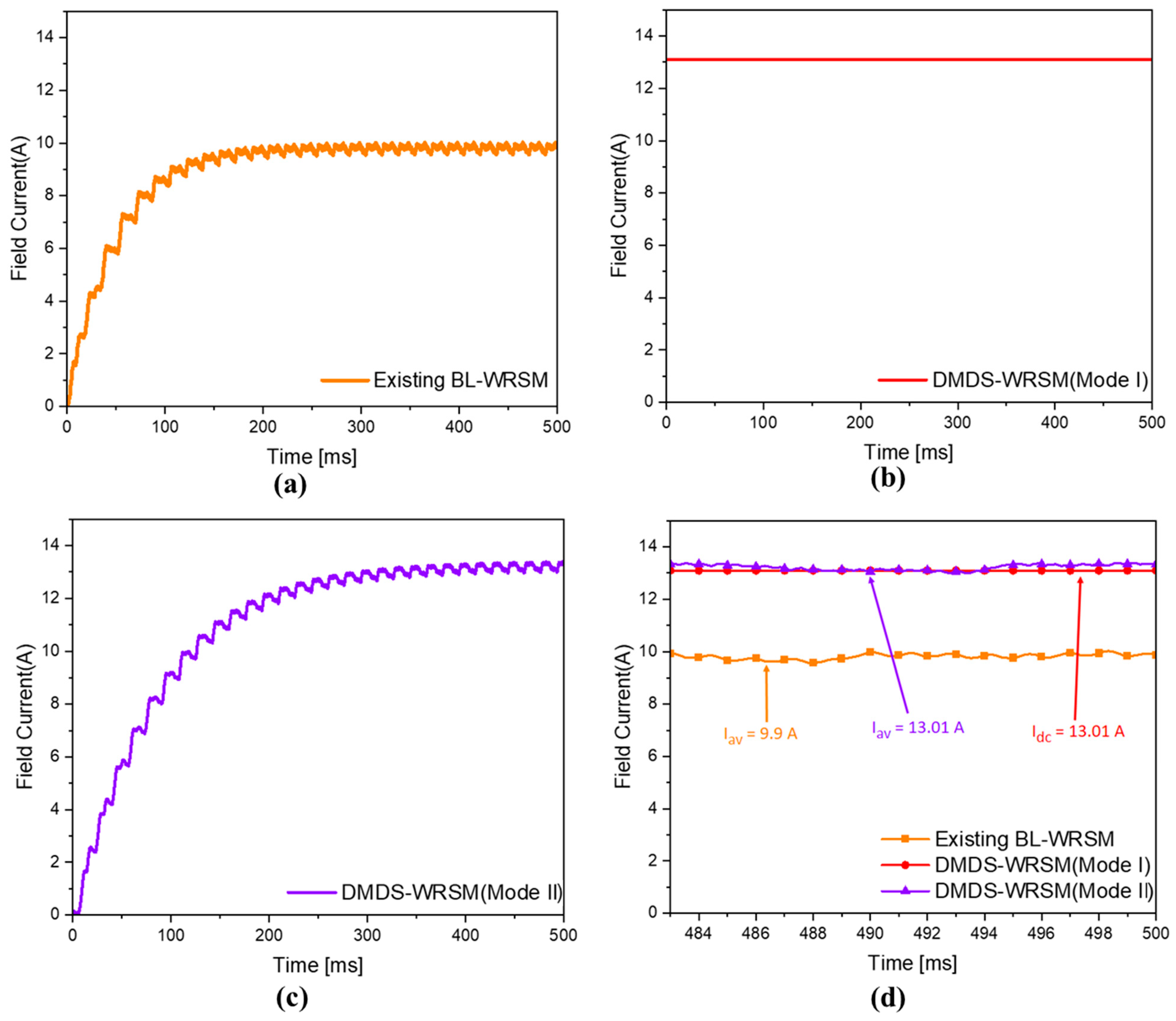
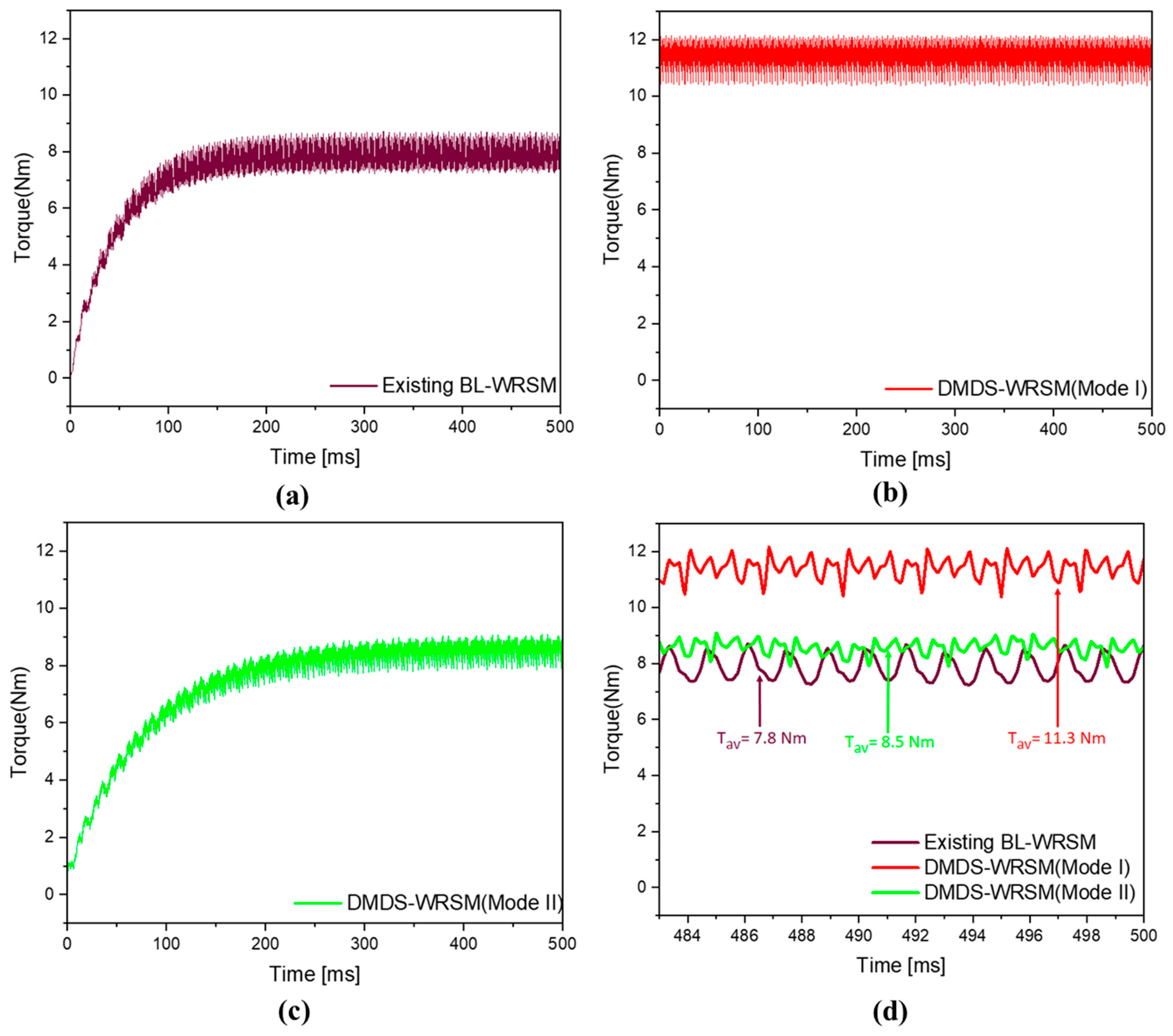

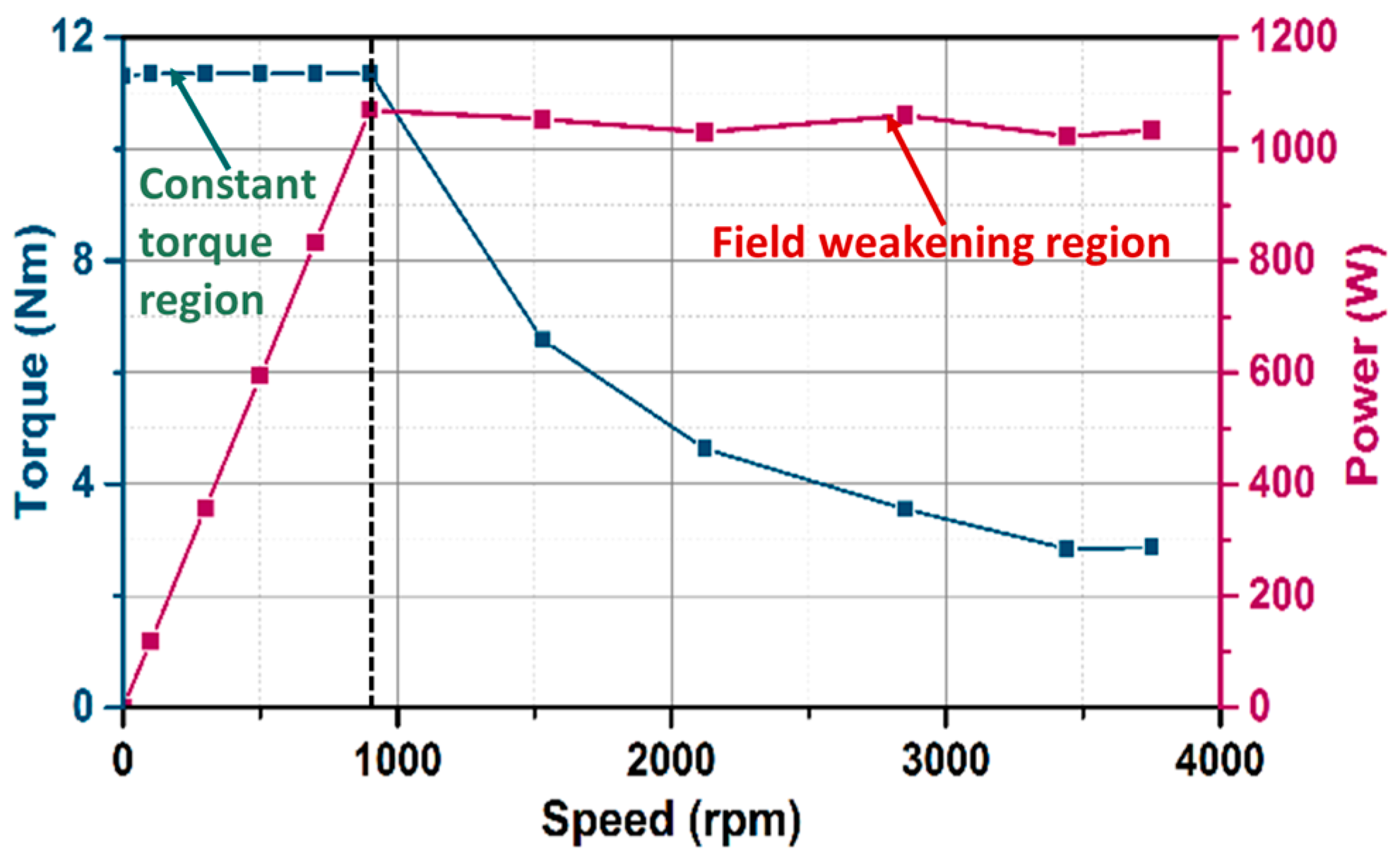
| Parameter | Units | Existing BL-WRSM | Proposed DMDS-WRSM | |
|---|---|---|---|---|
| Mode I | Mode II | |||
| Rated speed | rpm | 900 | 900 | |
| Number of stators | - | 1 | 2 | |
| Outer stator outer/inner diameter | mm | 177/95 | 164.5/127.5 | |
| Inner stator outer/inner diameter | mm | - | 101/50 | |
| Airgap length | mm | 0.5 | 0.5 | |
| Stack length | mm | 80 | 108 | |
| Winding ABC/XYZ turns per phase | - | 160/80 | 160/160 | 160/80 |
| Field/harmonic winding turns | - | 200/44 | 200/- | 200/32 |
| Machine volume | L | 3.03 | 3.01 | |
| Core material | - | 50H1300 | ||
| Parameter | Units | Existing BL-WRSM | Proposed DMDS-WRSM | |
|---|---|---|---|---|
| Mode I | Mode II | |||
| Power | W | 741.7 | 1066 | 802 |
| Torque | Nm | 7.8 | 11.3 | 8.5 |
| Torque ripple | % | 19.8 | 15.7 | 15.18 |
| Torque density | Nm/kg | 2.59 | 3.76 | 2.83 |
| Efficiency | % | 79.1 | 82.5 | 80.3 |
Disclaimer/Publisher’s Note: The statements, opinions and data contained in all publications are solely those of the individual author(s) and contributor(s) and not of MDPI and/or the editor(s). MDPI and/or the editor(s) disclaim responsibility for any injury to people or property resulting from any ideas, methods, instructions or products referred to in the content. |
© 2023 by the authors. Licensee MDPI, Basel, Switzerland. This article is an open access article distributed under the terms and conditions of the Creative Commons Attribution (CC BY) license (https://creativecommons.org/licenses/by/4.0/).
Share and Cite
Hussain, A.; Arif, A.; Bukhari, S.S.H.; Baig, Z.; Yazdan, T.; Shoaib, M. Novel Double Mode Dual-Stator Wound Rotor Synchronous Machine for Variable Speed Applications. World Electr. Veh. J. 2023, 14, 217. https://doi.org/10.3390/wevj14080217
Hussain A, Arif A, Bukhari SSH, Baig Z, Yazdan T, Shoaib M. Novel Double Mode Dual-Stator Wound Rotor Synchronous Machine for Variable Speed Applications. World Electric Vehicle Journal. 2023; 14(8):217. https://doi.org/10.3390/wevj14080217
Chicago/Turabian StyleHussain, Asif, Arsalan Arif, Syed Sabir Hussain Bukhari, Zafar Baig, Tanveer Yazdan, and Muhammad Shoaib. 2023. "Novel Double Mode Dual-Stator Wound Rotor Synchronous Machine for Variable Speed Applications" World Electric Vehicle Journal 14, no. 8: 217. https://doi.org/10.3390/wevj14080217
APA StyleHussain, A., Arif, A., Bukhari, S. S. H., Baig, Z., Yazdan, T., & Shoaib, M. (2023). Novel Double Mode Dual-Stator Wound Rotor Synchronous Machine for Variable Speed Applications. World Electric Vehicle Journal, 14(8), 217. https://doi.org/10.3390/wevj14080217







